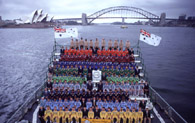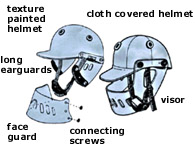
World Series Cricket
1977
one day cricket games redesigned for TV
Cricket-loving multibillionaire Kerry Packer wanted to show cricket on his commercial TV stations. He hoped to sell advertising during games and fill in the long summer non-ratings period with a popular sport that was cheap to televise.
But Australian cricket officials wouldn't sell him the broadcast rights, partly because his stations didn't cover the whole nation. So in 1977 Packer set up a rival competition, hiring many of the world's best players at better pay rates.
One-day cricket had been played at the top level before, but Packer's World Series Cricket competition was livelier and more colourful. He introduced day-night games - and a white ball that was easier to see at night. Instead of wearing whites, the players wore tight fitting coloured clothes to contrast with the ball (earning it the nickname 'the pyjama game'). He also improved the TV coverage, with coloured graphs to bring boring statistics to life.
After three years of bitter division between establishment and rebel players, cricket officials quietly gave in and Packer's TV stations now show five-day tests as well as one-day games. They have continued to innovate: there are now on-field microphones to catch players' comments, and stumpcam to give a ball's eye view of the action.
Another innovation that was introduced at around the same time was the Albion cricket helmet. Bowlers started bowling express bouncers, aiming for the head. But wearing an obvious protective helmet ?just wasn't cricket'.
In 1978 Tony Henson made a moulded cricket helmet from glass-fibre-reinforced plastic. Cleverly, he disguised it with a cloth cover and sun visor to make it look like a traditional flannel cap. He also designed a face guard of clear polycarbonate that could not be seen from a distance. Australian wicketkeeper Rod Marsh wore one in an international match and soon cricketers around the world wanted them so that they could look the part but be safe as well.
Who Did It?
Key Organisations
PBL Marketing : contracting, promotion
World Series Cricket Pty Ltd : management
Consolidated Press Holdings : funding, televising
Albion Hat and Cap Company Pty Ltd : R&D, design, manufacture of Albion cricket helmet
Key People
Kerry Packer : entrepreneur
Tony Greig : player who recruited others
John Cornell : entrepreneur
Tony Henson : innovator, designed Albion cricket cap
Further Reading
The cricket war
Gideon Haigh
The Text Publishing Company, Melbourne, 1993
Links
Radio
National, The Sports Factor. 23/5/97
Baggy
Green
Related Innovations
Racecam TV sport coverage
|












